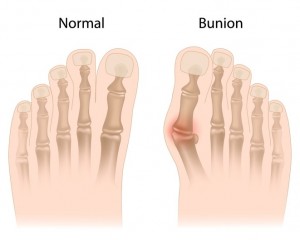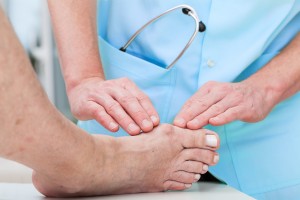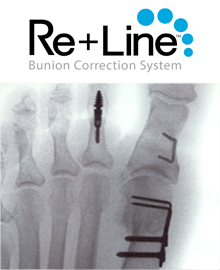Bunion
Stuart Katchis, M.D. is a leader in treating bunions and performing bunion correction surgeries. He has helped hundreds of patients get back on their feet pain-free with remarkable results. Whether your condition has just recently developed and can be effectively treated with nonsurgical options, or it is more advanced and requires surgery, Extend Orthopedics will plan and implement a treatment plan tailored to your needs.
For those patients needing bunion surgery, Extend Orthopedics is pleased to offer a cutting-edge procedure using the Re+Line® Bunion Correction System, a proprietary system that Dr. Katchis helped develop. The Re+Line® technology offers a unique, low profile tension band compression plate that delivers more precision, control and, best of all, faster recovery times for patients.
 What is a bunion?
What is a bunion?
A bunion, also referred to as hallux valgus, is a condition characterized by a bump on the side of the big toe that indicates a displacement of the metatarsophalangeal joint, which is located at the base of the big toe. While the bump along the side of the foot may be the most noticeable part of the condition, the deformity actually has to do with a shifting of the bony framework within the front part of the foot. It sometimes involves multiple bones drifting out of alignment. Bunions are one of the most common problems affecting the forefoot. As a progressive disorder, symptoms get worse over time.
What causes a bunion?
A bunion is caused when the metatarsophalangeal joint becomes unstable, which can lead to a partial or complete dislocation. As a result, the big toe begins drifting toward the second toe and the metatarsophalangeal joint starts to jut out on the outer edge of the foot. In nearly all cases, a bunion can be explained by an abnormal foot structure or abnormal foot mechanics that cause an imbalance of pressure on the ball of the foot and toe joints, eventually leading to instability in the big toe joint. Experts disagree on whether or not wearing tight or narrow shoes that crowd the toes actually causes bunions. Nevertheless, wearing ill-fitting footwear may speed up the progression of the condition.
What are the symptoms of a bunion?
If you have a bunion, you will likely experience:
- Pain or soreness at the base of the big toe or along the inside of the foot
- A bump on the outside of the big toe joint
- Swelling
- Inflammation
- Redness
- A burning sensation
- A loss of movement in the big toe
- Pain that worsens after long periods of standing
- Pain that worsens when wearing tight, narrow shoes or high heels
You may also experience numbness in the affected area and have difficulty finding comfortable footwear. In other cases, some patients with bunions may not experience any symptoms at all.
What are the risk factors for a bunion?
There are several factors that can increase your risk for developing a bunion:
- Gender – women are statistically more likely to develop a bunion than men
- Foot anatomy – certain foot types, including congenital foot deformities, make you more prone to developing a bunion
- Ill-fitting footwear – shoes that are too tight, narrow or shoes with high heels can speed up the progression of a bunion
- Prior toe injuries – significant or repeated injuries to the big toe and surrounding bones can exacerbate instability of the big toe joint
- Medical conditions – certain medical conditions such as rheumatoid arthritis place you at an increased risk for developing a bunion
- Occupation – jobs that place significant stress on the big toe, including those which require periods spent squatting or stooping, put you at a higher risk for developing the condition
What are the treatment options for a bunion?
 If you are experiencing pain or soreness at the base of the big toe joint that may be accompanied by a bump along the outer edge of the toe, call our office at 212‑434‑4920 or fill out the schedule appointment form on this page so Stuart Katchis, M.D. can evaluate and diagnose your condition. A bunion is a progressive condition that gets worse over time and treatment outcomes are significantly improved if medical evaluation is sought when symptoms first start. Most symptoms of a bunion can be improved with nonsurgical treatments, but in more severe cases, surgery may be recommended.
If you are experiencing pain or soreness at the base of the big toe joint that may be accompanied by a bump along the outer edge of the toe, call our office at 212‑434‑4920 or fill out the schedule appointment form on this page so Stuart Katchis, M.D. can evaluate and diagnose your condition. A bunion is a progressive condition that gets worse over time and treatment outcomes are significantly improved if medical evaluation is sought when symptoms first start. Most symptoms of a bunion can be improved with nonsurgical treatments, but in more severe cases, surgery may be recommended.
Nonsurgical Treatment
Nonsurgical treatment options may involve:
Applying ice
Applying ice to the affected area will help reduce pain and swelling.
Taking anti-inflammatory medications
Taking over-the-counter anti-inflammatory medications can considerably reduce pain. If necessary, Dr. Katchis may prescribe a stronger medication to improve your comfort level.
Altering footwear
Trade out tight, narrow shoes and high heels for wider shoes with soft, supportive soles. A wider foot bed and comfortable insole will allow the foot to spread out with less stress placed on the big toe joint.
Applying tape and padding
Taping and properly padding the big toe will provide it with more stability and insulation, which may significantly reduce pain and stress on the joint.
Using orthotics
Inserts placed in the shoes can help relieve pain and swelling by repositioning the foot and reducing pressure on the big toe.
Getting cortisone injections
Cortisone shots injected into the affected area may significantly reduce pain and discomfort.
Surgical Treatment
 Surgery may be required if nonsurgical treatments have not proven effective for improving symptoms and relieving pain, particularly in cases of more severe bunions. The type of surgical procedure recommended by Dr. Katchis will depend upon each patient’s unique situation.
Surgery may be required if nonsurgical treatments have not proven effective for improving symptoms and relieving pain, particularly in cases of more severe bunions. The type of surgical procedure recommended by Dr. Katchis will depend upon each patient’s unique situation.
Factors taken into consideration include:
- Severity of your bunion
- Your age
- Your activity level
- Condition of your bones and connective tissues
Surgical treatments include:
Tendon and ligament repair
A procedure for milder bunions or used in combination with other procedures, the surgery involves Dr. Katchis surgically removing damaged tissue then shortening the loose tissues and lengthening the tight tissues surrounding the big toe joint. This resizing of connective tissues around the big toe joint realigns the toe and helps it to stay in a straight position.
Re+Line® Bunion Correction Surgery
A cutting-edge realignment procedure for moderate to severe bunions that repositions and stabilizes the big toe joint using a unique, low profile tension band compression plate. The surgery involves Dr. Katchis inserting a proprietary bunion correction device along the side of the big toe that provides stable fixation of the big toe joint with long-lasting results.
Arthrodesis
A procedure utilized for more severe bunions, the surgery involves Dr. Katchis removing the damaged joint surfaces and fusing together the bones of the big toe joint. Special devices may be inserted to keep the bones in place while they heal together. After healing, the big toe will be fixed (unbendable), but pain is significantly reduced or eliminated.
Resection arthroplasty
A procedure that is typically performed in older patients with severe bunions, the surgery involves Dr. Katchis removing the damaged portion of the big toe joint. The surgery creates a flexible scar joint in the big toe.
What does the recovery process entail?
Surgical treatment for a bunion involves several weeks or months of recovery depending on the type of surgery performed. With any type of surgery for this condition, it may require you to wear a firm and flat postoperative shoe to protect your foot while the bones heal.
Whether you undergo nonsurgical or surgical treatment for a bunion, Stuart Katchis, M.D. will provide recommendations for long-term measures designed to keep your symptoms from returning, such as footwear modifications and orthotics.




You must be logged in to post a comment.